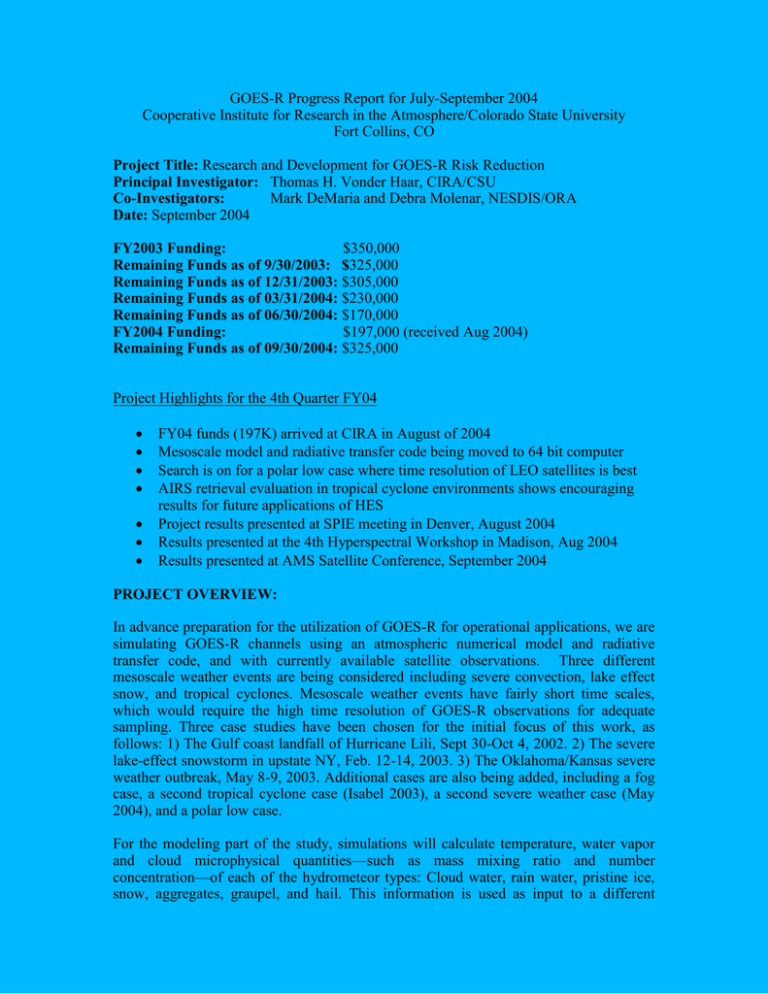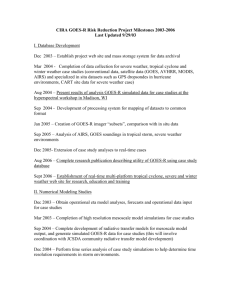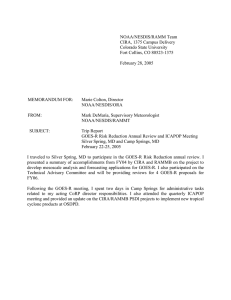GOES-R Progress Report for July-September 2004
advertisement

GOES-R Progress Report for July-September 2004 Cooperative Institute for Research in the Atmosphere/Colorado State University Fort Collins, CO Project Title: Research and Development for GOES-R Risk Reduction Principal Investigator: Thomas H. Vonder Haar, CIRA/CSU Co-Investigators: Mark DeMaria and Debra Molenar, NESDIS/ORA Date: September 2004 FY2003 Funding: $350,000 Remaining Funds as of 9/30/2003: $325,000 Remaining Funds as of 12/31/2003: $305,000 Remaining Funds as of 03/31/2004: $230,000 Remaining Funds as of 06/30/2004: $170,000 FY2004 Funding: $197,000 (received Aug 2004) Remaining Funds as of 09/30/2004: $325,000 Project Highlights for the 4th Quarter FY04 FY04 funds (197K) arrived at CIRA in August of 2004 Mesoscale model and radiative transfer code being moved to 64 bit computer Search is on for a polar low case where time resolution of LEO satellites is best AIRS retrieval evaluation in tropical cyclone environments shows encouraging results for future applications of HES Project results presented at SPIE meeting in Denver, August 2004 Results presented at the 4th Hyperspectral Workshop in Madison, Aug 2004 Results presented at AMS Satellite Conference, September 2004 PROJECT OVERVIEW: In advance preparation for the utilization of GOES-R for operational applications, we are simulating GOES-R channels using an atmospheric numerical model and radiative transfer code, and with currently available satellite observations. Three different mesoscale weather events are being considered including severe convection, lake effect snow, and tropical cyclones. Mesoscale weather events have fairly short time scales, which would require the high time resolution of GOES-R observations for adequate sampling. Three case studies have been chosen for the initial focus of this work, as follows: 1) The Gulf coast landfall of Hurricane Lili, Sept 30-Oct 4, 2002. 2) The severe lake-effect snowstorm in upstate NY, Feb. 12-14, 2003. 3) The Oklahoma/Kansas severe weather outbreak, May 8-9, 2003. Additional cases are also being added, including a fog case, a second tropical cyclone case (Isabel 2003), a second severe weather case (May 2004), and a polar low case. For the modeling part of the study, simulations will calculate temperature, water vapor and cloud microphysical quantities—such as mass mixing ratio and number concentration—of each of the hydrometeor types: Cloud water, rain water, pristine ice, snow, aggregates, graupel, and hail. This information is used as input to a different model—called an Observational Operator, to simulate GOES-R images. The Observational Operator will calculate radiative properties such as clear and cloudy sky extinctions, transmittances, optical depths, and other variables that will be used to produce the “synthetic” GOES-R satellite imagery. For the observational part of the study, satellite data is being collected from current sensors that have similarities with the GOES-R sensors. Although not all aspects of GOES-R can be simulated with current sensors, these data will provide valuable insight into the characteristics of GOES-R observations, and their application to mesoscale forecasting. JULY-SEPTEMBER 2004 ACCOMPLISHMENTS: 1.Data Collection: Collection of GOES, AIRS, AVHRR, and MODIS satellite data, and ancillary observations for the case studies is continuing. The database now includes 5 mesoscale cases. Work is proceeding to obtain a polar low case, where the time resolution of the MODIS and AVHRR data is optimal. A web site for displaying the various data types has also been established, and a more comprehensive database system is under development. ( see http://www.cira.colostate.edu/ramm/KFIntranet/GOESR_IPO/GOESR_IPO_case_study_database.html for further details) 2. Mesoscale Modeling: We have begun the transition to a new 64-bit single processor machine. As a first test, the 8 May 2003 simulation was set up with a total of three grids. Previously, the third grid had horizontal grid spacings of 4 km due to RAM limitation on the 32-bit machines. Now, the third grid has horizontal grid spacings of 2 km while the horizontal extent of the domain remains unchanged. Smaller grid spacings allows for not only improved resolution of convective triggering, but also such grid spacings match the approximate GOESR-ABI footprint. Further, more vertical levels have been added to improve the resolution of geometrically thin clouds in the upper troposphere; in particular, vertical grid spacings no longer exceed 500 m. During this first test, 5.6 Gbytes of RAM were successfully allocated after some compilier modifications. A few synthesized GOESR-ABI 10.35 µm images are shown in Figs. 1 and 2. 3. Radiative Transfer Modeling: The Observational Operator is being developed to produce simulated satellite images for the GOES-R instrument by including coefficients-specific to the sensor—in a subroutine called OPTRAN. We are also coordinating with the Joint Center for Satellite Data Assimilation (JCSDA) so that we can maximize the use of the community radiative transfer model to avoid duplication of effort with regard to this part of the project. In this quarter, additional code and subroutines were added to the observational operator to produce synthetic GOESR-ABI images that contain a solar component, ie, visible wavelengths to 3.9 µm. Further, the observational operator code has been converted from F77 to F90. To assist with the development and testing of the observational operator, a new option has been added to input specified fields, rather than that from the mesoscale model. observational operator to produce synthetic GOESR-ABI imagery of mesoscale events. That is, a user specifies the location of an idealized cloud, the depth, along with the number concentration and mass mixing ratio of any one or all of the seven hydrometeor types: Pristine ice, snow, aggregates, graupel, hail, rain, and cloud water. This model was designed specifically for outreach purposes to train forecasters with images of the GOESR-ABI channels and derived products. This model will not replace the mesoscale cloud model, but will be used as another tool for the analysis of GOESR-ABI images. Figure 1. Synthetic 2000 UTC GOESR-ABI 10.35 µm for the 8 May 2003 severe weather case. Note the enhanced-V signatures of the storms over eastern Kansas. Figure 2. Synthetic 2300 UTC GOESR-ABI 10.35 µm for the 8 May 2003 severe weather case. 4. Research and Applications: Several science studies will be performed that utilize the simulated GOES-R imagery described above. Progress on these studies is described below. a. Evaluation of Hyperspectral IR soundings: One of the first questions that will be explored is the information content of IR soundings from hyperspectral instruments. Temperature and moisture retrievals from the AIRS instrument for our case studies are being obtained from NESDIS/ORA and will be compared with in-situ data. For the Hurricane Lili case, special GPS soundings from the NOAA Gulfstream jet in the data void regions of the Gulf of Mexico have been obtained for comparison. AIRS and in situ soundings have also been collected for Hurricane Isabel and Hurricane Fabian from the 2003 hurricane season. In a preliminary study, 22 matching GPS sondes and AIRS retrievals were found for the hurricane Lili case while it was in the Gulf of Mexico. Figure 3 shows the average errors of the AIRS temperature retrievals for these 22 cases. The average errors were less 1.5 K in all atmospheric layers from 1000-200 hPa, and were much less than those from the NCEP Eta model first guess at these same locations in the lower troposphere. This result shows that the AIRS data are providing information that was not contained in operational NCEP analyses in the environment of hurricane Lili. The moisture errors were also examined, and the results showed that the AIRS retrievals have a large moist bias in the lower troposphere. We are coordinating with the AIRS retrievals group at ORA to determine the cause of the moist bias. Temperature Mean Absolute Error (K) 3 AIRS Eta Error (K) 2.5 2 1.5 1 0.5 0 1000-200 1000-750 750-500 500-200 Layer (hPa) Figure 3. Mean absolute error of AIRS temperature retrievals and those of the NCEP eta model first guess, relative to in situ GPS sondes from the NOAA Gulfstream jet for 22 cases in the environment of hurricane Lili. b. Hyperspectral Environmental Suite (HES) Data Availability Study: One of the potential advantages of the HES is the high temporal resolution provided by the geostationary platform. Three of the numerical model simulations (Hurricane Lili, the May 2002 severe weather case, and the Lake Effect snow case) will be used to estimate the number of relatively cloud free regions (determined by the cloud concentrations in the predictions) to determine potential usefulness of the HES for these types of meteorological phenomena. The impact of the required horizontal and temporal resolution of the HES will also be addressed. The development of synthetic Derived Product Imagery software was successfully tested for the severe weather case. This work will continue next quarter when the hurricane Lili simulation results become available. We anticipate writing a journal publication describing these results in the fall of 2004. c. Data Assimilation Studies: The impact of HES soundings will be assessed for the case studies using an idealized “identical twin” framework, followed by impact studies where AIRS and other GOES-R-like data are assimilated using an Ensemble Kalman Filter (EKF) data assimilation system. The EKF method has the advantage that the background error covariance matrix is predicted, rather than specified, and so it is flow dependent. Another advantage of the EKF method is that the adjoints of the cloud and radiative transfer models are not required. In the past quarter, work has continued on the application of the EKF framework to the RAMS model. d. Tropical Cyclone Intensity and Structure Diagnostic Algorithms: Both simulated and real data will be used to investigate new algorithms for estimating tropical cyclone wind structure and intensity from GOES-R observations. For this project, additional tropical cyclone observations, with emphasis on AVHRR and MODIS are being obtained. In the past quarter data collection for this study has continued. A fairly large dataset will be needed to develop a reliable objective algorithm. e. Severe Weather Nowcast Algorithms: Both simulated and real data will be used to investigate new algorithms for nowcasting and short-term forecasting of severe weather in the GOES-R era. The initial emphasis is on applications that rely on a combination of storm environmental parameters (thermodynamic profiles, etc) and storm parameters as determined by satellite-derived storm top structure and vertical profiles of satellitederived estimates of effective radius versus temperature. In the past quarter, an algorithm for estimating the effective radius of cloud droplets from IR imagery was obtained from NESDIS/ORA. A similar algorithm was obtained from Andy Heidinger from NESDIS/ORA. This code is being tested and adapted for use on current GOES and MODIS data so that the impact of the satellite resolution, and the relationships with severe weather can be evaluated. f. ABI Information Content Analysis: ABI imagery simulated from MODIS is being used in an information content analysis, to identify potential new products for mesoscale weather analysis and forecasting. Principal components are being calculated from a subset of the MODIS channels that are close to the ABI channels for each of the case studies. The contributions to the principal components from each MODIS channel helps to identify new methods for extracting information from combinations of the ABI bands. In the past quarter, the testing of the PCI technique on the case study data has continued and preliminary results were presented at the AMS conference on satellite meteorology and oceanography. 5. Presentations and Publications: Results from this project were presented the SPIE conference held in Denver in August of 2004, the 4th Hyperspectral Workshop in Madison Wisconsin in August of 2004, and the Satellite conference held in Norfolk, VA in September 2004. The references for these presentations and papers are listed below. SPIE, Denver CO, August 2004 Hillger, D.W., M. DeMaria, and R.M. Zehr: Advance Mesoscale Product Development for GOES-R Using Operational and Experimental Satellite Observations. Grasso, L.D., M. Sengupta, and M. DeMaria: Applications of Simulated GOES-R Observations for Advance Product Development for Mesoscale Weather Forecasting. 4th Hyperpsectral Workshop, Madison, WI, August 2004 DeMaria, M., D.W. Hillger, C.D. Barnet, J.P. Dunion, and R.T. DeMaria, 2004: Evaluation of Hyperspectral Infrared Soundings in Tropical Cyclone Environments (presentation). AMS 13th Conference on Satellite Meteorology and Oceanography, Norfolk, VA, September 2004 DeMaria, M., D.W. Hillger, C.D. Barnet, J.P. Dunion, and R.T. DeMaria, 2004: Evaluation of Hyperspectral Infrared Soundings in Tropical Cyclone Environments. Available from the preprint CD, 13th Conference on Satellite Meteorology and Oceanography, 20-23 Sept 2004, Norfolk, VA, American Meteorological Society. Dostalek, J.F., L.D. Grasso, M. Sengupta, and M. DeMaria: Applications of synthetic GOES-R observations for mesoscale weather analysis and forecasting. Available from the preprint CD, 13th Conference on Satellite Meteorology and Oceanography, 20-23 Sept 2004, Norfolk, VA, American Meteorological Society. Hillger, D.W., and T.J. Schmit: Quantization Noise for GOES-R ABI Bands. Available from the preprint CD, 13th Conference on Satellite Meteorology and Oceanography, 2023 Sept 2004, Norfolk, VA, American Meteorological Society. Hillger, D.W., M. DeMaria, and J.F.W. Purdom: Analysis of Simulated GOES-R Data and Products for Mesoscale Meteorology. Available from the preprint CD, 13th Conference on Satellite Meteorology and Oceanography, 20-23 Sept 2004, Norfolk, VA, American Meteorological Society. PLANS FOR THE NEXT THREE MONTHS: 1-3. Data Collection, Mesoscale Modeling, Radiative Transfer Modeling Work will continue on the data collection, numerical simulations, and observational operator development. In addition to the 64-bit single processor machine, a new 64-bit cluster with few dozen nodes and about 32 Gbytes of RAM will soon become available. Thus, the mesoscale model will be migrated to this new machine for testing. Although the mesoscale model has been successfully ported to a 64-bit machine, the code has not been tested to run in parallel. As before, the 8 May 2003 severe weather case will be used for the test. In addition, continued testing of the code to produce GOESR-ABI imagery with a solar component will continue. Lastly, work will continue on the new version of the observational operator with specified input, for radiative transfer code testing and for development of training material. 4. Research and Applications a. The AIRS/GPS sounding database for hurricane Lili will be expanded by adding the cases from Hurricanes Fabian and Isabel. All the AIRS retrievals will be re-run with a newer version of the code to see if the moist bias can be corrected. b. The DPI area study will be continue by adding results from the Lake Effect Snow and Hurricane Lili simulations. c. The EKF assimilation system formulation with RAMS will continue. A new Linux cluster is being purchased to speed up this development. d. Work will continue on the data collection for the tropical cyclone intensity and structure diagnostic algorithms. e. The formulation and data collection for the severe weather nowcast applications will continue. f. The principal component analysis will continue. The goal is to include at least one day from all of the case studies, and to compare day and night scenes. 5. Presentations and Publications An abstract describing the ensemble Kalman filter work, with emphasis on applications to GOES-R will be submitted to the AMS National Conference to be held in San Diego in January of 2004. Work will begin on a formal publication describing the spatial and temporal requirements for GOES-R for mesoscale applications. SPENDING PLAN: Initial FY03 funds arrived at CIRA in August 2003 and supplemental funds arrived in August of 2004. These combined funds should last until the summer of 2005. Spending has been: Jul 03 $0 K Aug 03 $5K Sep 03 $20K Oct $5K Nov $5K Dec $10 K Jan 04 $35K Feb 04 $ 20K Mar 04 $20K Apr $20K May $20K Jun $20 K Jul 04 $10K Aug 04 $10K Sep 04 $22K ($ 325 K remains of total project funds) For the next three months, spending is estimated to be: Oct $50K* Nov $20K Dec $20K. * Includes an anticipated 35K for a share in a new linux cluster being purchased at CIRA.


